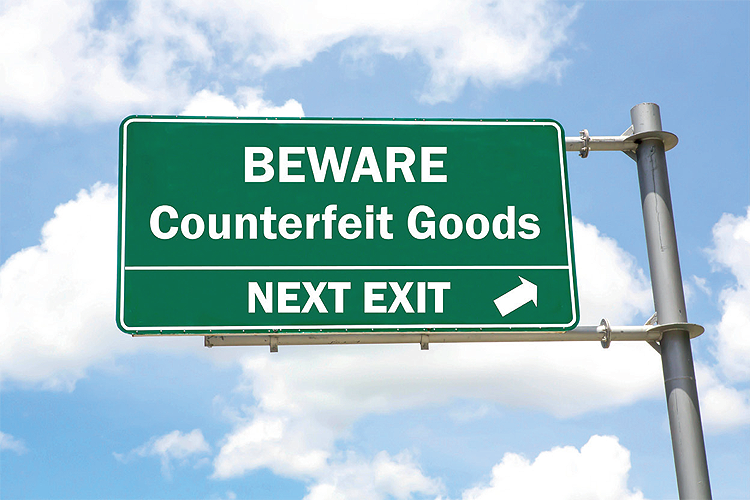
Combatting Counterfeiting: Safeguarding Authenticity in the Supply Chain
Counterfeiting is a very real and growing problem, with the sale of fake goods accounting for at least 3.3 percent of world trade. While many people commonly associate the counterfeit goods trade with the sale of fake luxury items, such as handbags and shoes, no industry is immune to its threat. Within the automotive sector, it is estimated that $2.4 billion is lost annually to counterfeit tire sales and $198 million to counterfeit battery sales in Europe alone. The huge scale of the problem has significant implications for brands, as not only does it severely impact their revenues, but it also has the potential to lead to brand dilution and poses a risk to consumer safety. Being able to ensure component authenticity is therefore of critical importance.
Although consumers can take measures to verify the authenticity of products before purchasing them, the most effective action is to counter the problem at the source, and this responsibility lies with brands. Fortunately, there are several methods brands can take to ensure authenticity in the supply chain, including using data to track products throughout the chain-of-custody and adopting covert, overt and forensic counterfeiting technologies.
Optimizing the use of data
Every product goes through a variety of processes and stages before they reach the end customer, but this exposes them to a number of infiltration points and leaves them vulnerable to nefarious actors. Consequently, to guarantee the authenticity of their products and identify where the supply chain might be breaking down and allowing counterfeit goods to enter it, brands must be able to determine the provenance of their products and trace each item back to every point in chain-of-custody.
The success of this approach lies in scoping out the many transition points that a product moves through and collecting metadata at each touch point. Metadata can range from what raw materials were used and where they were sourced, to the factory in which it was manufactured. Further down the chain, metadata can capture the volumes of items per pallet, where those pallets are being shipped to and the volume of items received at the other end. Brands could even collect this metadata down to a granular level of detail to track, for instance, the sizes and colors of items included in each particular shipment.
Adopting solutions that capture all of this data and mine it to identify anomalies allows brands to more easily identify deviations from the agreed route of their products and investigate it further. For instance, if a shipment of 38 pallets of a certain product is sent out for shipment, but only 35 end up at the final destination, it will be captured by the data, enabling the brand to trace it back to identify at which point the issue occurred to more easily resolve it. This level of traceability also serves to guarantee that the end product has been engineered using all of the specified parts from the required suppliers, so brands can ensure items baring their name comply with health and safety regulations, as well as any warranty stipulations.
Enhancing brand protection
Alongside this, brands can also adopt covert, overt and forensic security features to better authenticate and protect their product. With each type offering different levels of protection, brands can choose which best suits their needs and product, whether that’s a tamper-evident seal that is visible to the human eye or a hologram that incorporates forensic detection features and can’t be replicated by counterfeiters.
These features offer brands an extra level of protection against nefarious actors and it ensures that any products baring their brand name can be authenticated, either by the naked eye or by using detection technology. As well as being useful for brands and their customers, they can also be used by enforcement officials when products pass through customs. The tracking of these safety features can then become another source of data when monitoring an authentic product’s journey through the supply chain, from factory to the customer’s hands.
Providing proof points for customers
As consumers’ awareness of the impact of their shopping habits increases, complete provenance of products will also help brands to build consumer trust. This is because capturing data about components at their origins and being able to trace them back, also serves the purpose of helping organizations to answer consumers’ questions about where products originated, how they were manufactured and how they got to them. This will help to substantiate any claims a brand or product makes about being ethical or sustainable and help to instill consumer confidence in their offering and brand at large.
Some brands are even taking this one step further by tracking recycled products that are used in their products and what they were originally. For example, French company Veja uses recycled plastic bottles in the development of some of its sneakers. As sustainability becomes a bigger business objective for brands and manufacturers, this circularity, and the ability to detail it, is becoming increasingly popular.
Accountability in the supply chain
The growing threat from counterfeits requires brands to sit up and take action. With more effective use of their data and adopting the right strategies and technologies, it will become easier for brands to audit the supply chain process and add additional accountability and rigor to supply chain movements. As such, they can have confidence that only authentic items will make it onto the market, protecting their reputation, revenues and, ultimately, their customers.
Jim Keller is Global VP of Technology and Operations at OpSec Security.
OpSec Security has a long-standing history of delivering to global brands, institutions, and governments the most innovative and highest quality Brand Protection and Product Authentication Solutions that ensure the integrity of its customers’ brands, products, and services. In a world of rising fraud and counterfeit substitutes, it is the layer of truth that powers trusted relationships between customers and their customers.
www.opsecsecurity.com